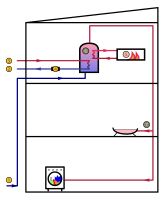
Photo from wikipedia
Abstract Background Flat plate solar collectors (FPSCs) can meet the needs of low-temperature process industries by providing a hot flow stream. In this regard, the addition of nanoparticles can improve… Click to show full abstract
Abstract Background Flat plate solar collectors (FPSCs) can meet the needs of low-temperature process industries by providing a hot flow stream. In this regard, the addition of nanoparticles can improve the energy-saving potential of the FPSCs. In this study, the effectiveness of using copper oxide (CuO) nanoparticles in a solar-assisted hot process stream was investigated. Methods Using transient-based numerical approaches, the efficacy of loading CuO nanoparticles at 0.1 vol.% into water on collector heat gain was examined. Using effectiveness–NTU method, the nanofluid efficacy was challenged by adding a two-pipe heat exchanger to diminish heating power usage in a hot process stream. Findings The results revealed that if a water-filled solar-assisted hot process stream was used, the energy-saving will be 670, 383 and 225 kWh m 2 . year at 60, 120 and 240 lit hr under Najran climate conditions. Taking into account energy-saving of 712, 415.5 and 242.5 kWh m 2 . year for nanofluid, it was found that incorporating CuO into a solar-assisted hot process stream has been successful. Owing to using CuO, the effectiveness of the solar-assisted hot process stream was improved within the range of 6-12.8%.
Journal Title: Journal of the Taiwan Institute of Chemical Engineers
Year Published: 2021
Link to full text (if available)
Share on Social Media: Sign Up to like & get
recommendations!